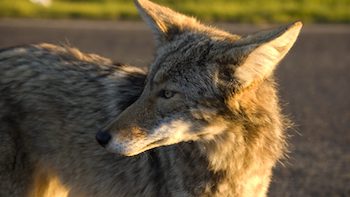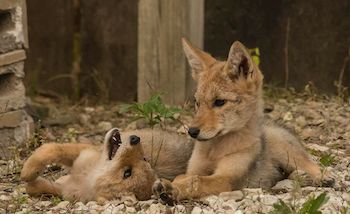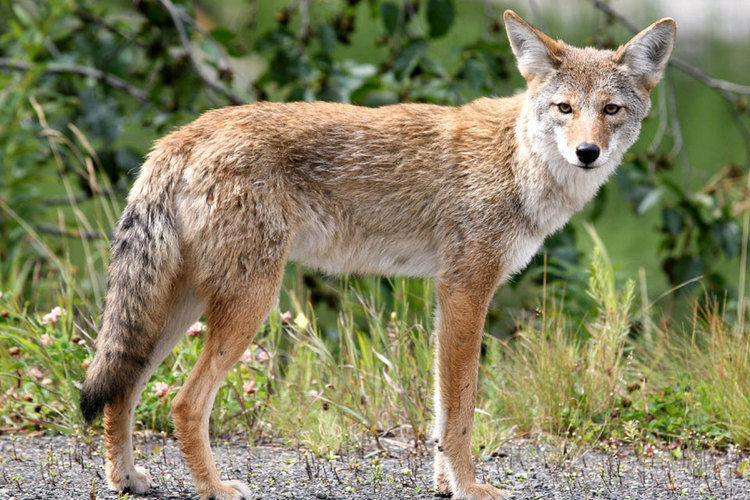Coyotes — Not in My Yard!
By Elizabeth Cornell Fake, Fairfax Master Gardener
 It was early morning when I spied a brown, furry presence in the corner of my eye. It sped across the front of the yard across the street. At first, I thought it was the errant Golden Doodle dog who resided in the neighborhood and was good at slipping its leash. But on further inspection, the same dog met up with another just like it and the two of them moved in a serpentine path down the street, weaving in and out of yards until they disappeared into the woods at the bottom of the street. They were unlike any of the usual neighborhood canines, and no owner was standing by ready to claim them. I decided they were probably some of the coyotes reportedly living in Northern Virginia’s suburban neighborhoods. The two visited the neighborhood on a regular basis about twice a week, usually very early in the morning about dawn and always as a pair running the same pattern of patrol, weaving in front and back of the houses ending their visit by running off into the woods.
It was early morning when I spied a brown, furry presence in the corner of my eye. It sped across the front of the yard across the street. At first, I thought it was the errant Golden Doodle dog who resided in the neighborhood and was good at slipping its leash. But on further inspection, the same dog met up with another just like it and the two of them moved in a serpentine path down the street, weaving in and out of yards until they disappeared into the woods at the bottom of the street. They were unlike any of the usual neighborhood canines, and no owner was standing by ready to claim them. I decided they were probably some of the coyotes reportedly living in Northern Virginia’s suburban neighborhoods. The two visited the neighborhood on a regular basis about twice a week, usually very early in the morning about dawn and always as a pair running the same pattern of patrol, weaving in front and back of the houses ending their visit by running off into the woods.
 I did some research and learned coyotes are not exclusive to western states but are present in every state, even Virginia. They were not native to our area until about the 1950s when they began moving in from the western states. Our urban coyotes differ from the Western breed as DNA analysis shows that they are a hybrid mix between the Western Coyote and Eastern Wolf. Their wolf characteristics give them a larger physical size than their Western cousins but a shyer nature. They would prefer to stay in uninhabited areas. However, as development has eroded the boundaries of their habitat, they have become suburban dwellers.
I did some research and learned coyotes are not exclusive to western states but are present in every state, even Virginia. They were not native to our area until about the 1950s when they began moving in from the western states. Our urban coyotes differ from the Western breed as DNA analysis shows that they are a hybrid mix between the Western Coyote and Eastern Wolf. Their wolf characteristics give them a larger physical size than their Western cousins but a shyer nature. They would prefer to stay in uninhabited areas. However, as development has eroded the boundaries of their habitat, they have become suburban dwellers.
 You can identify them by color and size. They resemble a small Collie dog about 20 to 45 pounds with long shaggy fur, pointed ears and a small muzzle. Usually they are gray to brown in color and have a light-colored belly, either a gray or cream color. They often have dark brown or black hairs blended into their back fur and bushy tail. You can also identify them by their slow, loping gait that is different from a dog’s. Usually they are nocturnal, but in the late winter or early spring, when feeding their pups, they venture out in the early morning or late afternoon to find food.
You can identify them by color and size. They resemble a small Collie dog about 20 to 45 pounds with long shaggy fur, pointed ears and a small muzzle. Usually they are gray to brown in color and have a light-colored belly, either a gray or cream color. They often have dark brown or black hairs blended into their back fur and bushy tail. You can also identify them by their slow, loping gait that is different from a dog’s. Usually they are nocturnal, but in the late winter or early spring, when feeding their pups, they venture out in the early morning or late afternoon to find food.

Domestic dogs track serpentine while exploring, whereas coyotes travel in a straight line.
In some cases, coyotes become accustomed to humans and are very bold and opportunistic in their search for food especially if food is left out for other wildlife. Even bread scraps left for birds make a tasty treat for coyotes. The first line of defense, of course, is to eliminate any environmental attractors that encourage their presence in your neighborhood. NEVER leave food for them.
The following are some basic actions to discourage coyotes:
- Eliminate food sources such as open trash cans, pet food left outside, and tasty tidbits left in compost piles. Avoid feeding feral cats.
- Be judicious in the selection and location of bird feeders. In addition to attracting squirrels and other rodents, bird feeders also attract coyotes who are looking for their next meal.
- Rake up fallen fruit from around fruit trees as coyotes enjoy eating fruit, berries and grains.
- Eliminate opportunities for creating a coyote-friendly habitat by keeping wooded areas brush free.
- Protect your pets by walking dogs on a leash and not leaving cats outside for long stretches of time.
- If confronted by or encountering a coyote, make a very loud noise by any means to scare it away so they do not become accustomed to being around humans.
- Talk to a wildlife biologist if you are concerned about coyotes in your neighborhood. Call the Virginia Wildlife Conflict Hotline at 1-855-571-9003.
References
• Living with Coyotes near your home in Virginia, Virginia Department of Game and Inland Fisheries
• Coyotes in Towns and Suburbs, U.S. Department of Agriculture, Animal and Plant Health Inspection
Services
• Coyote Tracks and Sign — An Online Field Guide, Alderleaf Wilderness College
• Coyotes live in almost all US cities. Here’s how to avoid trouble with them, Conservation Magazine,
September 20, 2016